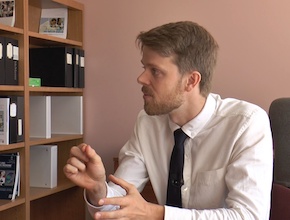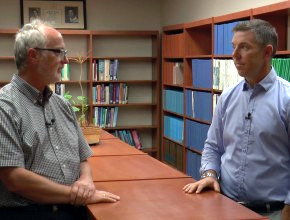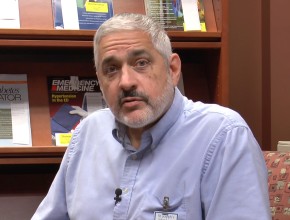Correction
This article was corrected on March 23, 2017.
The original video had a subtitle added at 05:15, saying “Negative CT that was performed less than 6 hours from presentation.” The subtitle was removed, as the meaning intended was clearly expressed by Prof Sherbino when saying “Negative CT that was performed more than 6 hours from presentation.” The transcript was revised accordingly.
Related McMaster Perspective episodes
Jonathan Sherbino, Roman Jaeschke. Acute cerebral hemorrhage: blood pressure control.References
Mark DG, Sonne DC, Jun P, et al. False-negative Interpretations of Cranial Computed Tomography in Aneurysmal Subarachnoid Hemorrhage. Acad Emerg Med. 2016 May;23(5):591-8. doi: 10.1111/acem.12941. PubMed PMID: 26918885.Roman Jaeschke: Good afternoon again, welcome to another segment of McMaster Perspective. We are here in the presence of Doctor [Jonathan] Sherbino, our main emergency department methodology and clinical practice consultant. What I would like to talk about is the paper that you proposed to review, which is the paper on subarachnoid hemorrhage. Could you tell us a little bit about it?
Jonathan Sherbino: I think this is a great paper, partly because the first author is a friend of mine who is a great methodologist, but more importantly, it is going to change my practice in how I manage subarachnoid hemorrhage. It was published online ahead of print in Academic Emergency Medicine in 2016, and interestingly, you told me in a sidebar before we began you thought it was technical. As a methodologist yourself, I hope it is not too technical for our audience, because I think it will change our practice.
RJ: Your goal is to make it nontechnical for our listeners.
JS: Let me see if I can do that in a couple of minutes or less. The biggest challenge I have right now is how do I proceed with a diagnostic workup for someone who presents with headache for which I am suspicious for subarachnoid hemorrhage. The dogma that I faced – and I think it truly is dogma rather than evidence – for the 15 years that I have been in practice is that if a computed tomography (CT) is negative, I should proceed with a lumbar puncture (LP). This paper performs a systematic review using exemplary methods, following all the PRISMA criteria, and comes up with findings that I think are important to highlight.
First off, there is no physical sign or presenting symptom for which the diagnostic properties, the negative likelihood ratio, will allow us to exclude the diagnosis of subarachnoid hemorrhage. Truly I am most interested in excluding this diagnosis, because the ongoing treatment and management is referral to a neurosurgical [service] for evaluation, so I am really looking to rule this diagnosis out. Interestingly, though, if we move to CT, there is good evidence that a CT using modern technology performed within 6 hours has a performance characteristic that effectively rules out the diagnosis of subarachnoid hemorrhage with quite tight confidence intervals to allow us to make that attestation, at the bedside, in a shared decision-making process with the patient; say, a negative CT 6 hours from onset of symptoms...
RJ: Or less.
JS: Or less essentially rules out the diagnosis. The interesting part comes because many of our patients will present more than 6 hours from onset. [The authors’] argument is that only in a very high-probability patient would the addition of an LP add any further diagnostic yield. They use a very interesting mathematical modelling, which I think will be the new way for us to approach these diagnostic dilemmas. A very interesting model: a mathematical modelling that allows you to put different parameters into the calculation in a kind of a very Bayesian fashion, where you simply align different diagnostic properties and different tests to reach a final posttest probability.
The LP by itself does not have perfect diagnostic properties; it has false negatives, it has an associated negative likelihood ratio. [The authors’] would suggest, based on their testing threshold, that a CT performed more than 6 hours from onset that is negative [in] a low- to moderate-probability patient probably does not warrant a further LP. It is only in a patient that has a pretest probability greater than 20% that we should consider performing an LP. That raises the big question that you and I have: “How can we be certain? I do not want to miss a single case.”
What this systematic review does, at least for me, is highlights there is no way for us to move down a testing parameter and get to no missed cases. It is an impossibility in our own mind, because all of these diagnostic tests have confidence intervals around the performance of that test, around their negative likelihood ratio, and none of them ever truly approach a 100% accuracy. What is this going to do to my practice today is that if I have a patient, [when] I examine them I am very confident in putting to mind that they have a pretest probably of 1 in 5 [of having] a subarachnoid hemorrhage. That is unusual.
RJ: You mean unusually high?
JS: That is unusually high. In the study, the prevalence of subarachnoid hemorrhage in their pooled estimate was about 7%. That is after hundreds of patients enrolled. So if I saw someone and said, “I have a very strong suspicion you have the exact, perfect, textbook description of subarachnoid hemorrhage,” only in that patient – which would be a very rare presentation – would I proceed to perform an LP after a negative CT that was performed more than 6 hours from presentation. That is a change, because my teaching has always been CT-LP. But I have always been reluctant to adopt that in a widespread fashion because LPs have complication rates, most notably to patients and their satisfaction, the exposure to pain.
This paper for me is a game changer because it gives us a strong evidentiary basis that defeats a previously held dogma, articulates that there is no such thing as 100% certain, and gives us a very reasonable approach. CT negative 6 hours or less from onset [and] I am done. CT negative in low to moderate probability, [even] more than 6 hours, [and] I am done. High probability, which for me means a 1 in 5 chance that you truly have the disease, and only in those rare cases am I going to perform a CT and then LP.
RJ: That represents a change in how you teach people and what you believe will find its way into practice guidelines, potentially?
JS: This is changing how I am teaching my generation of residents and fellows.
RJ: OK. Now a related question. Once we go into the theory of diagnostic tests, you realize there is no such thing as a 100% certainty that you do not have certain disease; I guess if you have no sugar/no elevation of blood glucose and no ketones, you know that you do not have diabetic ketoacidosis (DKA), but it is very rare. What you are saying here is that whatever we do, we always end up with some uncertainty similar to, say, D-dimers in suspicion of pulmonary embolism (PE). Even at the end of a diagnostic process you still are accepting a very small probability, knowing that to lower it you have to subject people to even more aggressive or potentially harmful tests. Am I getting it?
JS: I agree. To take on your example one step further, I do studies on cardiac biomarkers as well. I will tell you that unfortunately I have had to learn a lot of biochemistry and what we presume to be very binary when we read our computer printout, that our biomarker has a confidence interval and a normal distribution around the performance of that assay, it is not truly binary “yes” or “no”; in fact, there is a probability associated with how you report that number. We just have that illusion because we see a positive or negative for the ketones that you describe in your example of DKA. There is still diagnostic uncertainty; it is just so granular that it probably does not track to our thinking.
RJ: This paper is also probably a little granular, not necessarily black and white, but it may shift our behavior towards doing fewer LPs and trying to get a CT even faster than usually.
JS: I would tell our audience that if they are wrestling because intuitively they understand they are performing LPs with a very low pickup rate because it has been taught to them it is a dogma – headache, CT, LP – to pick up the paper, look at it for themselves and see if they develop some comfort with this idea that there is diagnostic ambiguity in all things that we do. We just need to have an approach where at the bedside we can have a conversation with our patients and say, “Here is the certainty with which we can make decisions, here are the pros and the cons, the benefits and the harms of further testing. How do you want to proceed in consultation with my explanation on backing evidence?”
RJ: They will probably ask you what you think, doctor.
JS: I am going to tell them, “6 hours or less, CT is negative, we are done.” Only in the rare condition where there is a very high incidence, high probability, with a CT performed more than 6 hours before, only in that rare occasion would I actually advocate for an LP.
RJ: Last question, I promise. Completely practical from my own perspective. How do you treat a person in whom you diagnose new-onset severe migraine in your emergency room and you are not worried about subarachnoid hemorrhage anymore?
JS: For symptomatic treatment alone, I think the first line is oral nonsteroidal anti-inflammatories. I think we have had a predilection to intramuscular or intravenous administration, but the pharmacokinetics of oral versus intravenous or intramuscular [agents] are such that I think it is completely reasonable to administer oral anti-inflammatories.
RJ: For example?
JS: Ibuprofen. Naproxen if you want to use a longer-acting [drug] or something with a longer half-life, and intravenous fluid administration – oftentimes patients are mildly volume-depleted because of nausea, not wanting to take fluids in, and on some occasions vomiting and losing some gastrointestinal fluids; [you may also consider] the administration of dopaminergic agents and Maxeran, which I cannot think of the generic form.
RJ: Domperidone?
JS: No... it is metoclopramide.
RJ: Metoclopramide. Let’s go back.
JS: The subsequent administration of metoclopramide – Maxeran is the trade name – which has a prodopaminergic effect. Stemetil…
RJ: What would be the dose? Prochlorperazine [the generic form of Stemetil].
JS: Stemetil/prochlorperazine would also be administered both intravenously and one or the other, so usually 10 mg for both [up to 10 mg per dose, intravenously or orally, for both prochlorperazine and metoclopramide].
RJ: That is easy.
JS: Moving on, if you want to look at regional anesthesia, I think occipital nerve blocks have a small role to play. And then into the controversial areas of the administration of narcotics. I think in recalcitrant migraine it is important we abort it. We know that patients who leave care without their headache being aborted have a prolonged course, often failed care, and after return to receive medical attention. And to prevent relapse… There is some evidence being published that high-dose steroids can prevent a relapse, probably because of this spreading neuronal wave of sterile inflammation that is described in the pathophysiology.
RJ: That would be one-time acute treatment in the emergency room, right?
JS: One-time acute treatment, oral or intravenous, looking at doses of long-acting steroids, like dexamethasone, probably in the range of 10 to 20 mg.
RJ: Wow! Thank you very much. I hope it is practical and I will try to remember it when I see the next patient.
JS: I hope I have not given you a migraine too much, Roman.
RJ: Thank you.
JS: My pleasure.
 English
English
 Español
Español
 українська
українська








